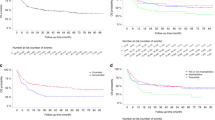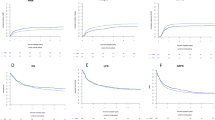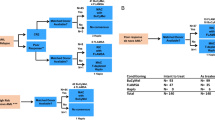Abstract
Between 1996 and 2004, a total of 708 patients were enrolled in the acute myeloid leukaemia (AML) ‘96 and ‘02 studies of the East German Study Group (OSHO). Of these, 138 patients (19.5%) had unfavourable cytogenetics defined as complex karyotype, del (5q)/-5, del (7q)/-7, abn (3q26) and abn (11q23). In all, 77 (56%) achieved complete remission 1 (CR1) after induction chemotherapy and were eligible for haematopoietic cell transplantation (HCT). HCT was performed after a median of two cycles of consolidation chemotherapy (CT) in the AML ‘96 and one cycle in the AML ‘02 study (P=0.03). After a median follow-up of 19 months, overall survival (OS) at two years was significantly better in the donor group (52±9%) versus the no-donor group (24±8%; P=0.005). Differences in outcomes were mainly because of a lower relapse incidence in patients after HCT (39±11%) compared with a higher relapse incidence in patients undergoing CT (77±10%; P=0.0005). Treatment-related mortality was low and not statistically significantly different between the two treatment groups (15±7 and 5±5% for HCT and chemotherapy, respectively; P=0.49).We conclude that early HCT from related or unrelated donors led to significantly better OS and leukaemia-free survival compared with chemotherapy in patients with unfavourable karyotype.
This is a preview of subscription content, access via your institution
Access options
Subscribe to this journal
Receive 12 print issues and online access
$259.00 per year
only $21.58 per issue
Buy this article
- Purchase on Springer Link
- Instant access to full article PDF
Prices may be subject to local taxes which are calculated during checkout





Similar content being viewed by others
References
Löwenberg B . Post-remission treatment of acute myelogenous leukemia. New Engl J Med 1995; 332: 260–262.
Stockerl-Goldstein KE, Blume KG . Allogeneic hematopoietic cell transplantation for adult patients with acute myeloid leukemia. In: Blume KG, Forman SJ, Appelbaum FR (eds). Thomas Hematopoietic Cell Transplantation, 3rd edn. Blackwell Publishing, Carlton, Victoria, Australia, 2004, pp 1025–1039.
Mrozek K, Heinonen K, De La Chapelle A, Bloomfield CD . Clinical significance of cytogenetics in acute myeloid leukemia. Semin Oncol 1997; 24: 17–31.
Jourdan E, Maraninchi D, Reiffers D, Gluckman E, Rio B, Jouet JP et al. Early allogeneic transplantation favorably influences the outcome of adult patients suffering from acute myeloid leukemia. Bone Marrow Transplant 1997; 19: 875–881.
Burnett AK, Wheatley K, Goldstone AH, Stevens R, Hann I, Hills RK . Long-term results of the MRC AML10 trial. Clin Adv Hematol Oncol 2006; 4: 445–451.
Suciu S, Mandelli F, De Witte T, Zittoun R, Gallo E, Labar B et al. Allogeneic compared with autologous stem cell transplantation in the treatment of patients younger than 46 years with acute myeloid leukemia (AML) in first complete remission (CR1): an intention-to-treat analysis of the EORTC/GIMEMAAML-10 trial. Blood 2003; 102: 1232–1240.
Frassoni F . Randomised studies in acute myeloid leukaemia: the double truth. Bone Marrow Transplant 2000; 25: 471–473.
Burnett AK . Current controversies: which patients with acute myeloid leukaemia should receive a bone marrow transplantation?--an adult treater's view. Br J Harmatol 2002; 118: 357–364.
Wheatley K, Gray R . Commentary: Mendelian randomization—an update on its use to evaluate allogeneic stem cell transplantation in leukaemia. Int J Epidemiol 2004; 33: 15–17.
Cornelissen JJ, van Putten WLJ, Verdonck LF, Theobald M, Jacky E, Daenen SMG et al. Results of a HOVON/SAKK donor versus no-donor analysis of myeloablative HLA-identical sibling stem cell transplantation in first remission acute myeloid leukemia in young and middle-aged adults: benefits for whom? Blood 2007; 109: 3658–3666.
Niederwieser D, Becker C, Krahl R, Al-Ali HK, Heyn S, Cross M et al. Increased leukaemia free survival (LFS) in patients with cytogenetic high risk AML after related or unrelated hematopoietic cell transplantation (HCT) compared to chemotherapy in the OSHO 96 and 2002 studies. Blood 2006; 108: 82a.
Petersdorf EW, Gooley T, Malkki M, Anasetti C, Martin P, Woolfrey A et al. The biological significance of HLA-DP gene variation in haematopoietic cell transplantation. Br J Haematol 2001; 112: 1–8.
Petersdorf EW, Gooley TA, Anasetti C, Martin PJ, Smith AG, Mickelson EM et al. Optimizing outcome after unrelated marrow transplantation by comprehensive matching of HLA class I and II alleles in the donor and recipient. Blood 1998; 92: 3515–3520.
McSweeney PA, Niederwieser D, Shizuru JA, Sandmaier BM, Molina A-J, Maloney DG et al. Hematopoietic cell transplantation in older patients with hematologic malignancies: replacing high-dose cytotoxic therapy with graft-versus-tumor effects. Blood 2001; 97: 3390–3400.
Niederwieser D, Maris M, Shizuru JA, Petersdorf E, Hegenbart U, Sandmaier B et al. Low-dose total body irradiation (TBI) and fludarabine followed by hematopoietic cell transplantation (HCT) from HLA-matched or mismatched unrelated donors and postgrafting immunosuppression with cyclosporine and mycophenolate mofetil (MMF) can induce durable complete chimerism and sustained remissions in patients with hematological diseases. Blood 2003; 101: 1620–1629.
Hegenbart U, Niederwieser D, Sandmaier BM, Maris MB, Stuart M, Greinix H et al. Treatment for acute myelogenous leukemia by low dose total body irradiation (TBI) based conditioning and hematopoietic cell transplantation from related and unrelated donors. J Clin Oncol 2006; 24: 444–453.
Sullivan KM, Agura E, Anasetti C, Appelbaum F, Badger C, Bearman S et al. Chronic graft-versus-host disease and other late complications of bone marrow transplantation. Semin Hematol 1991; 28: 250–259.
Przepiorka D, Weisdorf D, Martin P, Klingemann HG, Beatty P, Hows J et al. 1994 Consensus Conference on Acute GVHD Grading. Bone Marrow Transplant 1995; 15: 825–828.
Fefer A, Cheever MA, Thomas ED, Appelbaum FR, Buckner CD, Clift RA et al. Bone marrow transplantation for refractory acute leukemia in 34 patients with identical twins. Blood 1981; 57: 421–430.
Creutzig U, Reinhardt D . Current controversies: which patients with acute myeloid leukaemia should receive a bone marrow transplantation?—a European view. Br J Haematol 2002; 118: 365–377.
Chen AR, Alonzo TA, Woods WG, Arceci RJ . Current controversies: which patients with acute myeloid leukaemia should receive a bone marrow transplantation?—an American view. Br J Haematol 2002; 118: 378–384.
Litzow MR, Pérez WS, Klein JP, Bolwell BJ, Camitta B, Copelan EA et al. Comparison of outcome following allogeneic bone marrow transplantation with cyclophosphamide-total body irradiation versus busulphan-cyclophosphamide conditioning regimens for acute myelogenous leukaemia in first remission. Br J Haematol 2002; 119: 1115–1124.
Yakoub-Agha I, Mesnil F, Kuentz M, Boiron JM, Ifrah N, Milpied N et al. Allogeneic marrow stem-cell transplantation from human leukocyte antigen-identical siblings versus human leukocyte antigen-allelic-matched unrelated donors (10/10) in patients with standard-risk hematologic malignancy: a prospective study from the French Society of Bone Marrow Transplantation and Cell Therapy. J Clin Oncol 2006; 24: 5695–5702.
Slovak ML, Kopecky KJ, Cassileth PA, Harrington DH, Theil KS, Mohamed A et al. Karyotypic analysis predicts outcome of preremission and postremission therapy in adult acute myeloid leukemia: a Southwest Oncology Group/Eastern Cooperative Oncology Group study. Blood 2000; 96: 4075–4083.
Burnett AK, Wheatley K, Goldstone AH, Stevens RF, Hann IM, Rees JHK et al. The value of allogeneic bone marrow transplant in patients with acute myeloid leukaemia at differing risk of relapse: results of the UK MRC AML 10 trial. Br J Haematol 2002; 118: 385–400.
Author information
Authors and Affiliations
Consortia
Corresponding author
Rights and permissions
About this article
Cite this article
Basara, N., Schulze, A., Wedding, U. et al. Early related or unrelated haematopoietic cell transplantation results in higher overall survival and leukaemia-free survival compared with conventional chemotherapy in high-risk acute myeloid leukaemia patients in first complete remission. Leukemia 23, 635–640 (2009). https://doi.org/10.1038/leu.2008.352
Received:
Revised:
Accepted:
Published:
Issue Date:
DOI: https://doi.org/10.1038/leu.2008.352
Keywords
This article is cited by
-
Comparison of outcomes for patients with acute myeloid leukemia undergoing haploidentical stem cell transplantation in first and second complete remission
Annals of Hematology (2023)
-
The evolving concept of indications for allogeneic hematopoietic cell transplantation during first complete remission of acute myeloid leukemia
Bone Marrow Transplantation (2021)
-
Prognosis and risk factors for central nervous system relapse after allogeneic hematopoietic stem cell transplantation in acute myeloid leukemia
Annals of Hematology (2021)
-
Allogeneic hematopoietic stem cell transplantation improves long-term outcome for relapsed AML patients across all ages: results from two East German Study Group Hematology and Oncology (OSHO) trials
Annals of Hematology (2021)
-
HLA-mismatched stem cell microtransplantation compared to matched-sibling donor transplantation for intermediate/high-risk acute myeloid leukemia
Annals of Hematology (2019)



